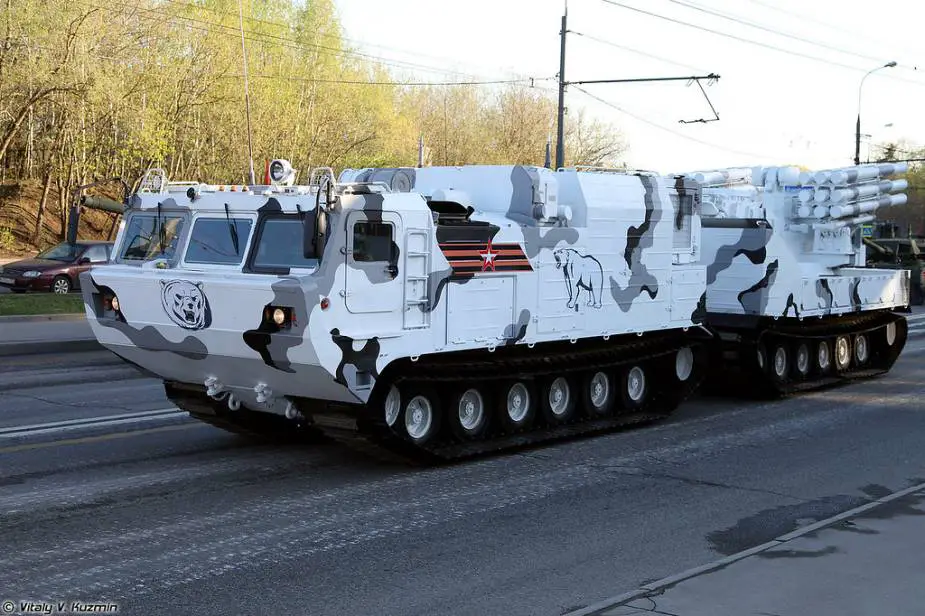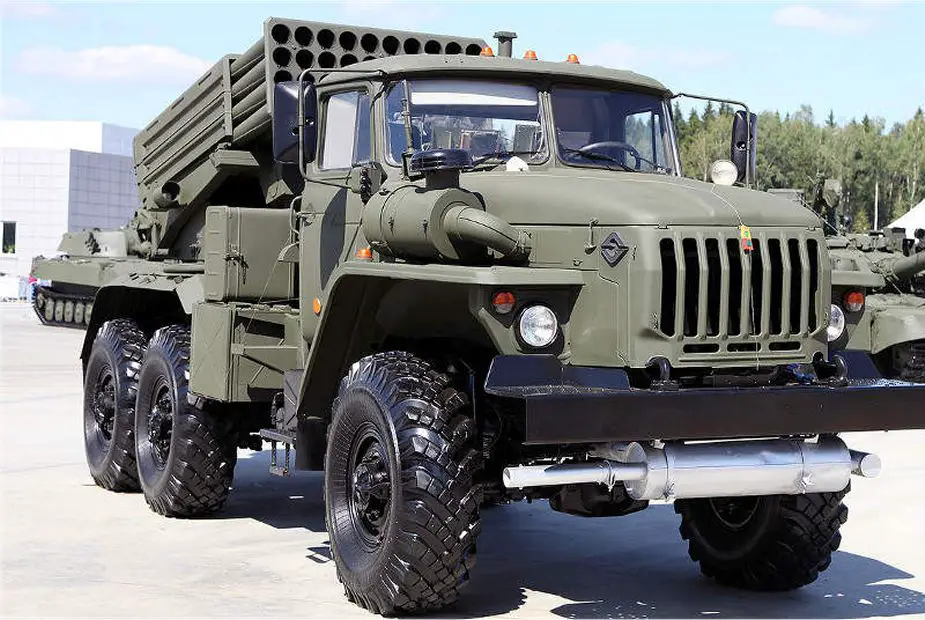Tornado-G multiple launch rocket system (MLRS) will be able to operate in hard-of-access northern regions. Head of the provision planning department of the mobilization department of the General Headquarters Major-General Alexander Dudkin said it had been decided to install it on the undercarriage of two-section DT-30PM Vityaz amphibious all-terrain vehicle, which already operates in the Arctic and carries Tor-M2DT and Pantsir-SM antiaircraft launchers, the Independent Military Review writes.
Follow Army Recognition on Google News at this link

As a comparison, a Pantsir-SA air defence system (not Tornado-G MLRS) on DT-30PM transporter chassis (Picture source: Vitaly Kuzmin)
Expert Vadim Kozyulin believes the MLRS on DT-30PM undercarriage both expands the capabilities of the carrier and changes the perception of potential armed conflicts in the Arctic. “At present, six military bases have been deployed there in Kotelny Island (of Novosibirsk Islands), Alexandra Land (of Franz- Joseph Land Archipelago), Sredny Island (Severnaya Zemlya), Rogachevo settlement in Novaya Zemlya, Cape Schmidt and Wrangel Island in Chukotka. There is also a dozen of military airfields, antiaircraft positions and military seaports. The infrastructure has to ensure uninterrupted navigation by the Northern Sea Route, which is the shortest way from Europe to Asia, and defend the country against a potential US missile strike,” he said.
Until recently, the military deployed mostly antiaircraft weapons in the region. MiG-31BM fighter jets went on combat duty to keep cruise missiles and other attack weapons away from Russian borders, he added. “Vityaz with Tornado-G shows that the Russian General Headquarters fear hostile warships, aircraft and cruise missiles and a large-scale intrusion of the land forces. We have dozens of oil, gas and other strategic deposits in the North. Multiple launch rocket systems are necessary to destroy adversary troops and hardware,” expert Viktor Murakhovsky said. The Arctic brigades do not have large-caliber artillery because of geographic specifics. The maximum-caliber weapon is 120mm mortar. It is clear that DT-30 with Tornado-G is much more powerful, he said.
Wheeled MLRS have been supplied to the army since 2014. The weapon is a successor to Grad, but enjoys bigger maneuverability, modern navigation, guidance and calculation of ballistic indicators. All the operations are automatic and accelerate the engagement time.
Several new 122mm rockets were designed for Tornado. Item 9M217 has a cluster warhead of 25 kg with armor-piercing submunitions. The range is 30 km and they can pierce 60-70 mm of homogenous armor. 9M218 projectile carries a cluster warhead and is armed with submunitions with better characteristics. They can pierce 100mm armor.
Tornado engagement in the Arctic was restricted by the capabilities of the carriers. Vityaz is unique due to major cross-country capacity. It can drive in marshlands, cross rivers, overcome snow packs, and operate at temperatures of minus 45 to plus 40 degrees Centigrade. There are three options of the vehicle with a carrying capacity of 10, 20 and 30 tons. They allow creating any hardware for the Extreme North.
In 2017, the Defense Ministry organized two sorties of Vityaz in the Extreme North. The first one began in the northernmost Yakutian settlement of Tiksi and went to Kotelny Island and returned via St. Nos Cape, Dmitry Laptev and Sannikov Straits in the Laptev Sea. The second took place in Novaya Zemlya Archipelago. The experimental sorties tested new technical solutions in tracked vehicles, which promote autonomous operation in cold temperatures and readiness for missions, as well as the ability to drive in packed and deep snow in Polar night and snowstorms with a wind of 35 meters per second.
The Defense Ministry is currently procuring several Vityaz modifications. They carry overhaul, evacuation and residential vehicles. Besides MLRS, Vityaz can carry an automatic mortar or artillery speed gun. The platform reinforces the Russian troops in the Arctic, the Independent Military Review said.

Tornado-G 122 MLRS Multiple Launch Rocket System. (Picture source: Army Recognition)
© Copyright 2021 TASS / Army Recognition Group SPRL . All rights reserved. This material may not be published, broadcast, rewritten or redistributed.














